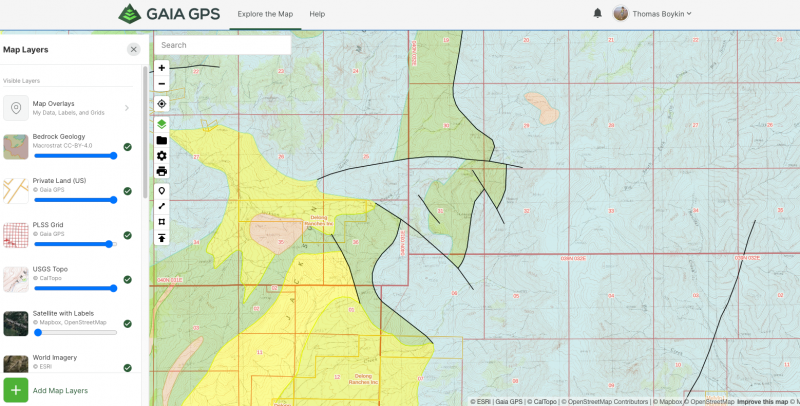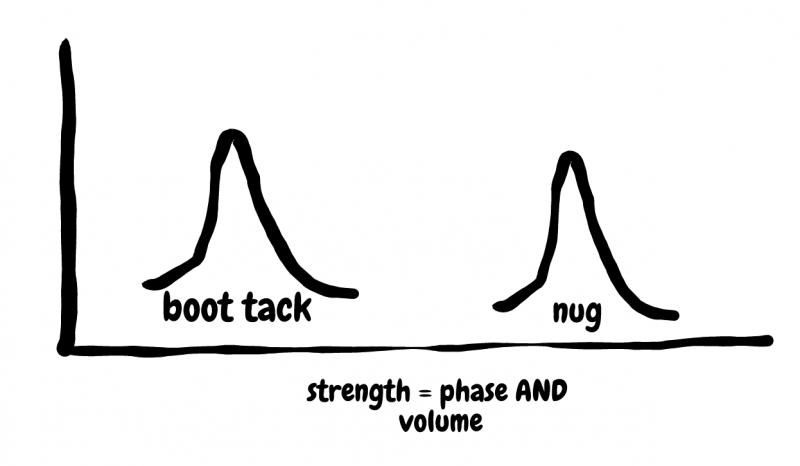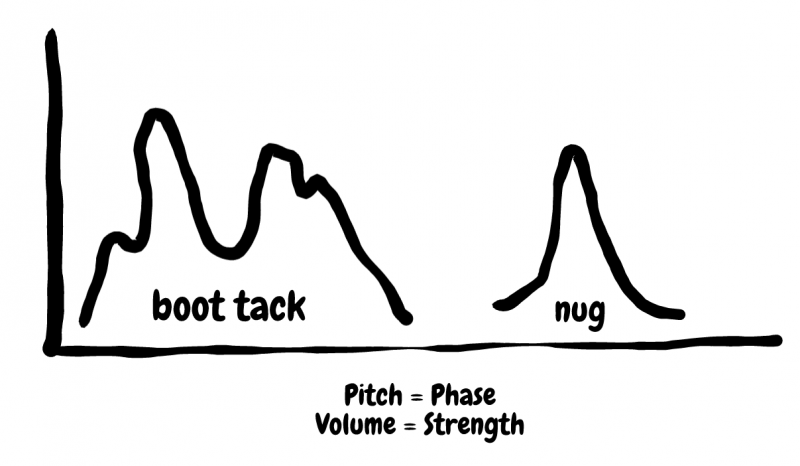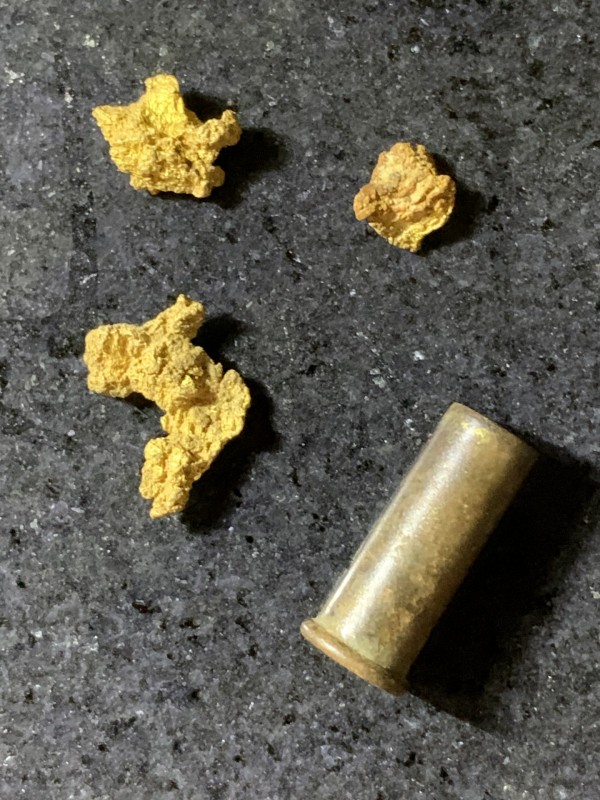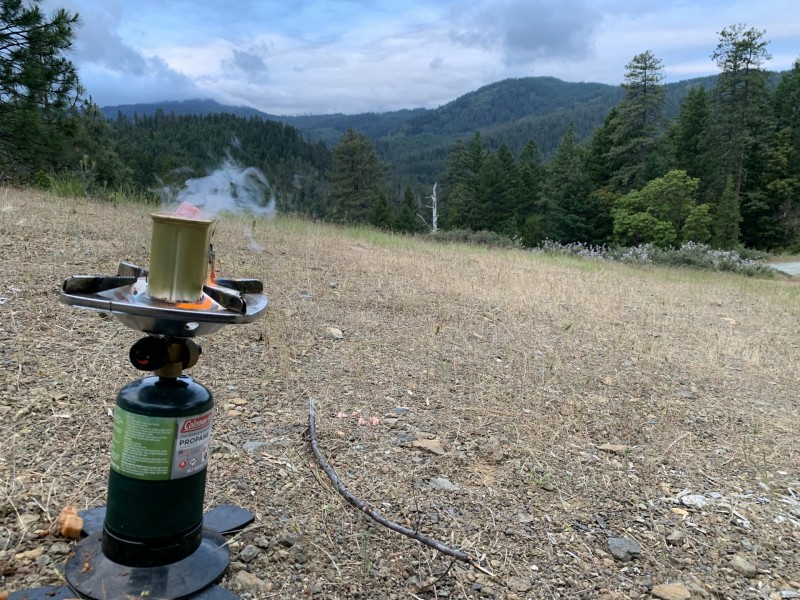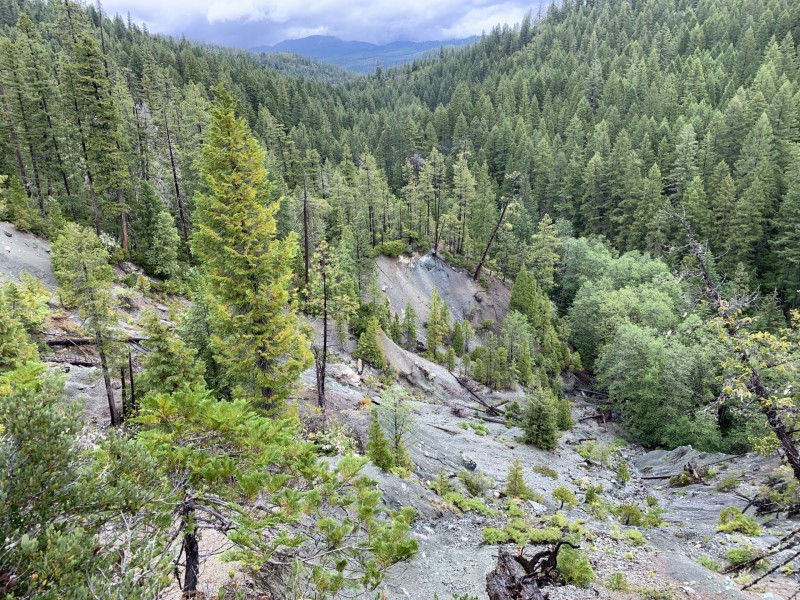-
Posts
595 -
Joined
-
Last visited
-
Days Won
11
Content Type
Forums
Detector Prospector Home
Detector Database
Downloads
Everything posted by tboykin
-
Custom Maps For Smartphone GPS App
tboykin replied to Denver Bryan's topic in Detector Prospector Forum
Gaia GPS does this. You can see in my screenshot I have overlayed the bedrock geology, PLSS Grid, and land ownership onto the USFS topo. -
I have been looking into these. My current pack is all on my shoulders and can weigh around 30lbs on longer trips. A frame pack is a good idea.
-
A few areas have semi-clean water so I can either drink it straight or add iodine if I’m not feeling like Rambo. But many are dry or have extremely gross water. I have found that when the temperature is over 95 I can go through about 2 gallons per day - depending on how many holes I dig and how deep. But still a great idea to keep the treatment in the pack, very small and lightweight.
-
White's Electronics Out Of Business
tboykin replied to PopeyePapa's topic in White's Metal Detectors
-
I could use some advice from the true adventurers out there. I have used a regular backpack for the past 4 years and it has gone with me all over the West (and even in the Amazon jungles of Brazil) on my detecting adventures. Inside I carry food, water, first aid, extra coil, TP, and other essentials. I have strapped sleeping bags and gold pans to the outside. I have it ready to go for at least one or two nights sleeping in mild weather. But the miles have taken their toll. For those of you who venture far from your vehicle into the bush, I would like to know what kind of pack you use. Pics and advice are welcome. I am looking for something that can carry 1-2 gallons of water, a sleeping bag, battery bank, possibly the ability to strap my detector and pick to it for long hikes, and either waterproof or with a rain cover. Price is not important. I have an old frame pack I could use but it is gigantic.
-
That sounds perfect. We will check out towns before moving. I had enough of the big city life in LA and prefer tiny towns. I have good memories of growing up in small towns and wish the same for my kids.
-
That is perfect, thank you Steve.
-
In an effort to convince my wife to move to Nevada, I would like to know more about gemstones and non-metallic fossicking/collecting in the Silver State. If I can show her that the state will be a great place for other rock collecting, it will add greatly to my "gold, gold, no state income tax, gold" argument for a move. We are looking in the Hawthorne/Fernley/Fallon area. I know about the opal mines up by Virgin Valley, and garnets found in the Ruby mountains. And of course the different gold and silver districts, which sadly, she doesn't care about. She is most into roaming the desert and surface hunting while I swing a detector nearby. My attempts at putting a detector in her hands have not been successful, even when finding gold nuggets. Maybe she is broken. Anyways I'm mostly interested in personal experience, pictures, and anecdotes of gemstones and other non-metallic surface finds in the state. Please don't post your spots, keep those secrets to yourself!
-
Minelab 2021 - Five Key Products
tboykin replied to Steve Herschbach's topic in Minelab Metal Detectors
A lab will test metal detectors as “unintentional radiators.” Some detector companies choose to risk not having them tested, but according to the part 15 statement: This device complies with Part 15 of the FCC Rules. Operation is subject to the following two conditions: (1) This device may not cause harmful interference, and; (2) This device must accept any interference received, including interference that may cause undesired operation. In order to ensure a detector complies with this it is taken to a lab, exposed to interference, and measured for harmful interference at different settings. The findings are submitted to the FCC in a giant stack of paperwork and gets approved, making the product “FCC compliant.” It is an extremely boring and tedious process! Any device that transmits or receives using an antenna (which is all a search coil is) needs to be tested in order to be sold legally. -
The whole point of this idea is to give your brain and ears more raw information to process. A good analogy would be seeing with two eyes instead of one. The Zed does give you a warble or wobble over certain targets, and I think that kind of descriptive audio or even more descriptive audio can be applied to any detector that gives you two sets of data (signal strength and signal phase or x and y for ZVT/pulse) in all-metal mode. Machine learning still has a long ways to go before it can rival a human, provided whiskey hasn't killed off too many brain cells. There is more raw audio information to be presented to a user that isn't currently being explored.
-
Detecting started out as an audio-only hobby, and for us prospectors it mostly remains that way. Even if you are just swinging a VLF you can't trust the VDI numbers in hot ground. Beep, beep, dig. Now the more experienced detectorists know that there is a lot more to audio signals than just beeps. There is shape, tone, volume, sharpness, rhythm. It becomes a musical performance that we get to decode with our brains to decide whether a target is worth busting out the pick for. Why have detector companies not put more emphasis on developing audio responses? We get screens, target ID's, GPS, wireless audio, but the same old sounds. But the most important user experience - the sound the detector makes - has not changed much. For all-metal VLF or PI detectors you get a VCO audio response that rises with signal strength. That's it. Ok, so rant mode off, now my pitch. A simple mapping of a normal VCO (voltage-controlled oscillator) audio signal is SIGNAL STRENGTH = PITCH and VOLUME change. This goes back to the time when a hardware oscillator was directly tied to the audio output and use the signal voltage to create an audio signal. You get a zip on all targets, and though the shape of the signal will vary based on what the target is, there is no indicator of target phase (or X/Y component). You want any audio info on that for a VLF, you have to switch to a tone mode. Here is what a boot tack and and nugget sounds like on a VLF with a normal VCO audio (like a gold machine or all-metal mode): Now if you were to instead tie the PITCH of the signal to the PHASE, and the VOLUME to the STRENGTH, you would get more information. It might look like this: You can get a response similar to this by using 50 tones on the Equinox, but to my knowledge, no detector uses this kind of audio mapping in VCO mode. Do you see how much more information this would present to a seasoned detectorist? Especially with iron targets, which tend to have a very confused signal, the pitch would jump all over and should be easier to distinguish. I believe this type of audio response might be able to be used with the GPZ (it's kind of there already with the hi/low tones) or any other detector that reads X and Y signal responses. Instead of having both PITCH and VOLUME tied to the composite signal like it's 1950, the responses would be independent and give the user more information - no screen required. For beginners this would not be good since it is hard enough for them. Hope this makes sense, let me know what you think (especially CARL).
-
For Those Who Go Out Prospecting I Have A Few Questions
tboykin replied to bigtim1973's topic in Detector Prospector Forum
How much does it supplement your income? I have gotten lucky a few times out and found enough to pay off some gear or pay for the trip, but in general, the trip is the reward. In the US, small-scale prospecting and mining are mostly hobbies. The economics just don't work out for it to be more than that. I look at it like hunting or fishing. Is that buck really worth all that I spent on my rifle, tags, time off, vehicle, camo, and scouting? Not if you count it in dollars. The experience is what you are really mining, not the gold. But finding gold is always a great feeling and hard to compare to other hobbies. Heart goes from zero to sixty real fast. What about chiggers and ticks, do you have to deal with those pesky critters too out in dry climates? Always smart to check your creases for ticks. I usually get one or two a year. Out west in certain areas the poison oak is more troublesome, and it pays to be prepared for it with either Tecnu or Dawn. Also snakes, spiders, bears, scorpions, centipedes, wolves, and cougars depending on where you are. Mostly they leave you alone, but you need to be aware of your surroundings and have a plan for each situation. Other than your machine and digging stuff, what else does one take along while prospecting for those just in case you need it scenarios? I have a daypack with food, water, compass, first aid, extra socks, rain cover, bear spray, gold pan, water purifier, and bunch of other stuff I forgot. It stays packed so I can grab and go. In some areas I will lug a pistol around due to bears. Also, a good 4x4 vehicle is a must if you want to get harder to reach areas which may have more gold. Boots without steel toes are helpful since the machine will signal on them. Do you hunt mostly on a claim or public land? Have done both but I prefer the freedom of public land. -
My GPZ didn’t have too many issues with my .40 but it is just under my ribs, higher than a drop leg or typical belt holster. Heavy gun and I’ve only had to fire it once to warn a target shooter that I was down range. Sometimes I leave it at home but if it’s bear or wolf country I take it. Honestly a .22 or .38 would do just as well since it’s mostly to scare, not kill. Regular cleaning is important. My last outing I probably collected a few ounces of dirt and mud in my gun since I was bushwhacking and we had some downpours.
-
White’s Electronics Done After 70 Years
tboykin replied to Steve Herschbach's topic in White's Metal Detectors
I agree completely. I’m not an engineer (never was), just a hobbyist now. I might be competitive with them in arm wrestling or a foot race though. ”Trust me bro, it’s a cracking detector” should have been enough to ink a deal on the QED. I know it’s selling by the tens of thousands right now and this singular decision would have saved the company. Having that decision back I should have flown to Oz for a very specific demonstration where I had no control over the conditions, spending triple what simply purchasing the detector would have cost. All I can do now is use my tears to wash all the gold I’ve found stateside with my Minelabs. Sarcastic banter aside, you can’t pin White’s situation down to any one thing. Steve made a great point about the responsibility of owners to steer the ship. There are also market changes, demographic shifts, and worldwide events happening. New companies have quickly gained ground on established ones. Lots of factors, some that we probably don’t even recognize. It is sad, but everything has its time. You. Me. Countries, businesses, religions. Nothing lasts forever. Except gold. -
White’s Electronics Done After 70 Years
tboykin replied to Steve Herschbach's topic in White's Metal Detectors
The negotiations were as follows more or less: QED creator: “this is a great gold detector you’d better jump onboard” Me: we would like to buy one to check it out, we’ll cover shipping as well. QED: “Sorry mate we are back ordered and also it’s hard to post stuff to the US. We need an agreement now.” Me: we can buy one right now, just let me know how much. Or fly you out to SH for a demo and pay for your ticket QED: “so let’s talk royalties” Me: we need to check out the performance of the detector and see how it stacks up to the GPX first. QED: “trust us mate it’s a great detector, come down to oz for an optimized demonstration in a specific location and we can sign an agreement, thinking 40-50% would be right” Me: let me know when we can buy one and I can test it in a few locations in the US, I’ll gladly sign an NDA. QED: ***crickets*** -
White’s Electronics Done After 70 Years
tboykin replied to Steve Herschbach's topic in White's Metal Detectors
There are quite a few challenges faced by an American detector company right now, some of which I got to see in great detail being in charge of product development at White's (and lots that I will keep under my hat out of respect to an NDA). But the obvious ones related to manufacturing and development are: Increased US labor costs versus other countries where detectors are built Increased part and shipping costs Distribution networks based on 20th century ways of doing business Decreased ROI on research and development Any American company that cannot answer these challenges will struggle to survive in what has become a crowded niche industry. Saying "but we've always done things this way" is a great epitaph. Taking too long to release a product (looking at you FTP) or making products that only target a slice of the tiny niche market (Tesoro's analog undoing) are both shortcuts to "retiring" a company. Garrett has been lucky to ride on the fumes of their marketing efforts while developing an also-ran product that follows on the heels of entry-level Minelab and Nokta/Makro (Makta? Nokro?) products. There are also some general hobby-related issues that are putting the squeeze on the industry worldwide: Decreased access to detecting areas Decreased finds due to target depletion Increasing regulations A customer base that's aging out without replacement The above adds up to less people detecting each year. YouTube videos will have you believe otherwise, but in the real world the hobby is dying a slow death of attrition, and guys who are getting too old to swing a detector. So how will a manufacturer address these issues and stay in business? By making the hobby accessible to younger newcomers. By investing in marketing and market research. By building a product lineup that includes affordable, mass-produced, simple detectors as well as advanced, high-margin, bleeding edge flagships that appeal to hobby veterans (we call this "product mix" in business). The industry and hobby will likely continue to slowly shrink, and it will take tens of millions of dollars invested in engineering projects and marketing for businesses to stay solvent as the pie gets smaller every year. So you damn well better have enough profit to make that happen, or have an investor with deep pockets and a flair for risk-taking who is willing to take those long odds of success. If a company has neither, the only rational decision is to call it and go fishing. But for the ones that can solve these problems, they will be able to gobble up pieces of the pie that are left on table by companies that cannot adapt. The three years I worked at White's were absolutely incredible. It introduced me to a new hobby, amazing people, and experiences I would not have had if I hadn't taken a risk on a career switch in 2016. It's sad that White's is closing its doors, and my heart goes out to all of the wonderful people I worked with in Sweet Home. -
That would be great. I’ve been researching a few areas between Canyon City and Baker City that you might be interested in as well. I sold my GPZ when I realized I wouldn’t be detecting as much as I’d like but when I’m in the market for a new one you’ll be my first call Gerry. Luckily it found enough gold when I had it to where it’ll be an easy time convincing the wife.
-
Yes I can’t wait wait till my kids are old enough to enjoy digging. My wife is not a fan of camping or detecting so I’m hoping at least one of the kids will be into that stuff. But they may not have a choice.
-
I think the 24k would have found these just as easy or maybe even easier, but I really like having one machine that can do it all. The market is getting more and more competitive and it’ll be interesting to see what comes from Fisher and White’s to meet those challenges. It was great working for White’s and I wish them the best. Right now I’m waiting for a discriminating ZVT... but with two toddlers I can afford to wait. Most of you guys will be in retirement homes then, so more gold for me 😋
-
After being sequestered with too much audio production work I was itching for a rare excursion to the goldfields of Southern Oregon. When I used to work in the metal detector industry it was great to have these outings be a part of my work, testing new machines or shooting videos. But it left little time for actual detecting and learning some basic geology. I am still dumber than most on both fronts! I bought a GPZ and it found enough gold to just about pay itself off, but later sold it to a friend when I realized that with two young kids my outings would be separated by months, not weeks. Better for it to be used every weekend by a real miner! So I bought an Equinox 800 since I would be relegated more to dirty diapers than dirty fingernails. But could it find gold? Pictured above is 1.6 grams of hard-earned Oregon gold (with the ubiquitous .22 shell casing for scale) out of a hydraulic mine. But you’ll notice the fluffy, pocket-gold nature of it. All I can say is there is a lot of interesting geology down there. And the old timers knew how to move dirt! Since I’m a hobbyist now the gold is nice but I also take the time to enjoy the view (and some Spam for breakfast). No bears around camp but we did see a nice sow on one of the spur roads deep in the woods. I was hunting side by side with my friend, who was swinging the GPZ. He found 3 small pieces also but I beat him on weight. Lucky this time. I will say that the hot rocks and extreme soil changes were difficult, but I knew that would be the case with a VLF. Thankfully a lot of the hot rocks were volcanic so a little “boot discrimination” helped along with a selective notch and adjusting the recovery speed up when things got too noisy. The smaller piece I would not have found with these settings as the VDI rang up same as one of those little red and black hot rocks, but had a nice subtle zip that helped me separate it out from about five hot rocks in a one foot square area. That nugget comes in at about 4 grains and the GPZ couldn’t hit it even on the surface since it was so porous and has some host rock still attached. I am torn on using the Nox in all metal or with some disc and found myself switching back and forth, going over the same ground twice. This gold was found in ground that has been detected many times by experienced hunters and took a careful ear (and often equally careful recovery since it was in clay). All gold found with the 6” coil.
-
Sadly I have the found the best option for this is to leave my fem at home. This came after suggesting that she could nag the rocks instead of me as they'd be more sympathetic listeners.
-
This is key. Some of the areas I'm keen on are not on maps, or there is little more written about them than "hydraulic mining operation, unknown production." They are well outside the "gold belt" where I'm used to going. Maybe it was difficult to get supplies there, or the men moved on to easier diggings. Definitely worth a gander.
-
Morning all. It's been an interesting few years for me with a change of jobs and two new family additions. After "scratching the itch" HARD last year I realized that with two young kids it's best to cool off on spending days and weeks in the bush away from the family. I still go on trips and find gold, it's just become more special and less of an every month deal. Which makes research extra-important! In reading up on specific gold districts in certain areas, there are two main categories: High-producing, well-known districts that have been worked from about the 1850's to 1930's, with current claims for hobbyists or small-time mining operations. These are concentrated in areas with a larger area of interesting geology. Lower producing small districts that are scattered well-away from the above larger areas that were worked from the 1850's to late 1890's and are not popular today. These are spread out, sometimes 50+ miles away from well-known districts, and feature "anomalous geology" such as a narrow sliver of surface greenstone and quartz veins surrounded by newer volcanic formations. In the past I have concentrated on well-known districts (#1) as many old timers have told me "go where the gold is." It makes sense to me - if there was a lot of gold in an area and recovery was not good, there is a bigger chance of finding some small crumbs missed by others. However these areas are well-known to all and detected by many. So I try to focus on fringe areas in these districts that are harder for people to get to. It's "low risk, low reward," and I realize now, potentially the wrong tactic in today's world where it's getting harder to find nice chunks. My thinking on hitting some of the smaller, scattered areas (#2) is that with less modern attention, even if there was less gold recovered, there may be more overall gold left behind by old timers. Simple target depletion - work stopped over 100 years ago, and these areas have been left alone since then, leaving more potentially good targets to find. I'm curious what you think about following the path less-travelled to some of the smaller, less-popular districts.


